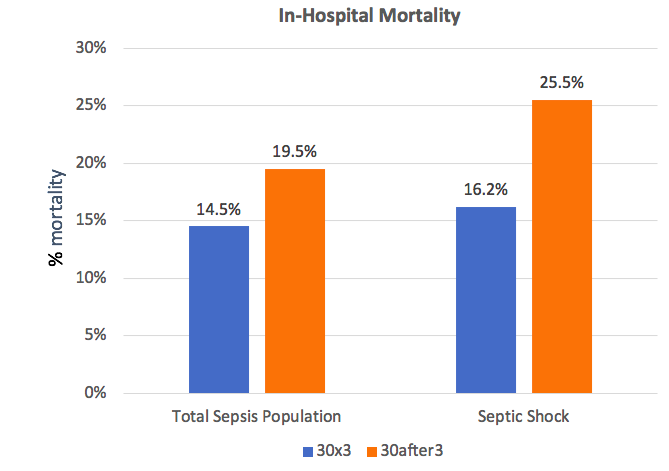Recent Paper Demonstrates Survival Benefit Regardless of Comorbidities

A recent study published in the November 2019 issue of Critical Care Medicine sought to evaluate the effect of achieving the Surviving Sepsis Campaign’s recommendation of a 30ml/kg bolus within 3 hours of identification for patients with septic shock.1 This recommendation has been the source of significant controversy, particularly for patients who are perceived to be at risk of adverse effects from fluid bolus therapy.
Kuttab and colleagues performed a retrospective cohort study of adults presenting to the emergency department of an urban, tertiary care center (n=1032), and evaluated the predictors of achieving a 30ml/kg fluid bolus within 3 hours of identification of severe sepsis or septic shock, or “30by3.” The authors also assessed impact of 30by3 on mortality and other outcomes, particularly among patients perceived to be at risk for harm from fluid resuscitation.
In this study fewer than half of patients received their 30ml/kg within three hours, and failure to achieve 30by3 resulted in higher mortality (odds ratio 1.5) and longer ICU stay. Figure 1 shows the mortality reductions among patients who received 30by3. Those less likely to receive 30by3 had end stage renal disease or heart failure, or were elderly, obese, or perceived by the clinician to have volume overload. Interestingly, the lowest mortality occurred in patients who received 35-45ml/kg in the first hour. Patients who received 30-35ml/kg had a lower risk of endotracheal intubation than those at the low or high extremes of fluid volume.
This study is consistent with a number of other recent papers demonstrating the mortality benefit of early fluid administration in septic shock.2–5 Leisman and colleagues showed that initiation of the 30ml/kg fluid bolus within 30 min of septic shock recognition reduced mortality and length of stay.3,4 Patients with heart failure and renal disease were less likely to receive fluids early, but had the identical mortality benefit when their resuscitation was initiated within less than 30 minutes.3 Another Leisman study demonstrated that delay in initial fluid resuscitation was the most significant risk factor for developing fluid-refractory septic shock, which was itself a predictor of increased mortality.6

Figure 1. In-hospital mortality for the total sepsis population and subset of septic shock in patients receiving 30ml/kg fluid in <3 hours vs. 30ml/kg over 3 hours.
These studies all suggest that fluid timing matters. The detrimental effects of excess fluid balance in the ICU are well known, but they occur during a phase of care in which the patients may no longer be responsive to fluids. Intravenous therapy provided beyond 24 hours of presentation is distinctly different from fluid resuscitation provided in the early minutes of care and directed at the reversal of shock and hypotension. Even brief periods of arterial hypotension in the initial phase of sepsis lead to tissue ischemia and are associated with increased mortality.7,8 The use of early fluid therapy for targeted reversal of hypotension in shock patients is associated with improved outcomes in many studies,2,4–6 and may actually decrease the need for and consequences of subsequent fluid.6 As the article by Kuttab has demonstrated, this is even true in patients with a history of congestive heart failure or chronic renal failure, the very patients for whom providers may be reluctant to provide a fluid bolus.6,9 Withholding adequate resuscitation in severe sepsis and septic shock patients can actually lead to worse outcomes in these patients.
This study is a valuable addition to the literature on the treatment of severe sepsis and septic shock. The results further support previous data showing that early fluid resuscitation improves survival and reduces hospital length of stay and help focus our attention on the urgency of early and targeted treatment in septic shock.
Interested in learning more about rapid, controlled delivery of a fluid bolus with LifeFlow? Contact us.
- Kuttab HI, Lykins JD, Hughes MD, et al. Evaluation and predictors of fluid resuscitation in patients with severe sepsis and septic shock. Crit Care Med. 2019;47(11):1582-1590. doi:10.1097/CCM.0000000000003960
- Lee SJ, Ramar K, Park JG, Gajic O, Li G, Kashyap R. Increased fluid administration in the first three hours of sepsis resuscitation is associated with reduced mortality: a retrospective cohort study. Chest. 2014;146(4):908-915. doi:10.1378/chest.13-2702
- Leisman DE, Goldman C, Doerfler ME, et al. Patterns and outcomes associated with timeliness of initial crystalloid resuscitation in a prospective sepsis and septic shock cohort. Crit Care Med. 2017;45(10):1596-1606. doi:10.1097/CCM.0000000000002574
- Leisman D, Wie B, Doerfler M, et al. Association of Fluid Resuscitation Initiation Within 30 Minutes of Severe Sepsis and Septic Shock Recognition With Reduced Mortality and Length of Stay. Ann Emerg Med. 2016;68(3):298-311. doi:10.1016/j.annemergmed.2016.02.044
- Williams JM, Greenslade JH, Dymond CA, Chu K, Brown AFT, Lipman J. Characteristics, treatment and outcomes for all emergency department patients fulfilling criteria for septic shock: a prospective observational study. Eur J Emerg Med. 2018;25(2):97-104. doi:10.1097/MEJ.0000000000000419
- Leisman DE, Doerfler ME, Schneider SM, Masick KD, D’Amore JA, D’Angelo JK. Predictors, prevalence, and outcomes of early crystalloid responsiveness among initially hypotensive patients with sepsis and septic shock. Crit Care Med. 2018;46(2):189-198. doi:10.1097/CCM.0000000000002834
- Marchick MR, Kline JA, Jones AE. The significance of non-sustained hypotension in emergency department patients with sepsis. Intensive Care Med. 2009;35(7):1261-1264. doi:10.1007/s00134-009-1448-x
- Varpula M, Tallgren M, Saukkonen K, Voipio-Pulkki L-M, Pettilä V. Hemodynamic variables related to outcome in septic shock. Intensive Care Med. 2005;31(8):1066-1071. doi:10.1007/s00134-005-2688-z
- Liu VX, Morehouse JW, Marelich GP, et al. Multicenter Implementation of a Treatment Bundle for Patients with Sepsis and Intermediate Lactate Values. Am J Respir Crit Care Med. 2016;193(11):1264-1270. doi:10.1164/rccm.201507-1489OC

